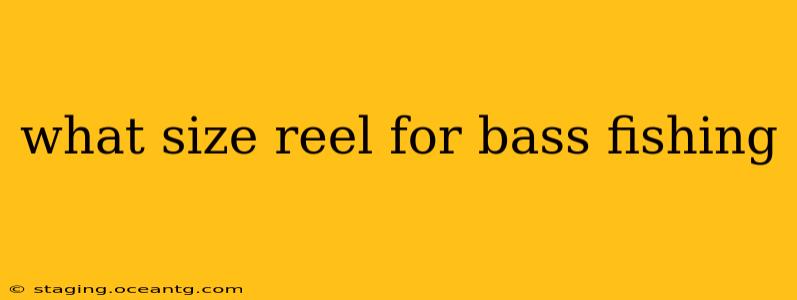What Size Reel for Bass Fishing? Finding the Perfect Match for Your Rod and Technique
Choosing the right reel size for bass fishing is crucial for a successful and enjoyable experience. The ideal size depends on several factors, primarily the type of bass fishing you're doing and the rod you're using. This guide will break down everything you need to know to select the perfect reel.
Understanding Reel Sizes:
Reel sizes are typically represented by a number, often ranging from 1000 to 8000 or higher. This number isn't a direct measure of physical size but rather an indication of the reel's capacity and gear ratio. A higher number generally means a larger reel with a greater line capacity and, often, a lower gear ratio. However, this isn't a universal rule, as different manufacturers may use slightly different sizing scales. Always refer to the manufacturer's specifications for accurate information.
Factors Influencing Reel Size Selection:
1. What type of bass fishing are you doing?
-
Light Tackle/ finesse fishing: For finesse techniques like drop-shotting, shaky head jigs, and small spinnerbaits targeting smaller bass or in pressured waters, a smaller reel (size 2000-3000) paired with a light to medium-light power rod is perfect. These reels offer excellent sensitivity for detecting subtle bites.
-
Medium Tackle: This is the most versatile setup for bass fishing, effective for a wide range of lures and techniques. A medium-sized reel (size 3000-4000) matched with a medium-power rod is suitable for crankbaits, Texas-rigged plastics, and spinnerbaits. It offers a good balance between sensitivity and power.
-
Heavy Tackle: For targeting larger bass with bigger lures or when fishing in heavy cover, a larger reel (size 4000-6000 or even higher) is needed. This setup typically pairs with a heavy-power rod and is ideal for big swimbaits, jigs, and frogs. The increased capacity allows for longer casts and the ability to handle powerful runs from large bass.
2. What is the line capacity?
The line capacity of the reel should match the type of line you're using and the size of the lures you'll be throwing. You want enough line to handle a strong fish's run without running out. Check the reel's specifications to see how much line it can hold at different pound tests.
3. What is the gear ratio?
The gear ratio indicates how many times the spool turns for every turn of the handle. Higher gear ratios (e.g., 7:1 or higher) are better for fast retrieves, while lower gear ratios (e.g., 5:1 or lower) provide more power for cranking in larger lures or fighting bigger fish. Consider the types of lures you'll be using when choosing a gear ratio.
4. What type of rod are you using?
The rod's power and length play a role in reel selection. A light rod will generally require a smaller reel, whereas a heavier rod can handle a larger reel. Balance is key; you want a setup that feels comfortable and easy to use.
Examples of Reel Sizes for Different Bass Fishing Scenarios:
- Smallmouth bass in clear water with a drop-shot: 2500-3000 size reel.
- Largemouth bass in heavy cover with a jig: 4000-6000 size reel.
- Florida-style fishing with topwater lures: 3000-4000 size reel.
- Punching mats with heavy jigs and weights: 6000-8000 size reel.
Conclusion:
Choosing the right reel size for bass fishing isn't about picking the biggest or smallest available. It's about finding the perfect balance between capacity, power, and sensitivity, tailored to your preferred techniques and fishing style. By considering the factors discussed above, you can select a reel that will enhance your fishing experience and improve your chances of landing that trophy bass. Remember to always consult the manufacturer's specifications to ensure compatibility with your rod and line.
